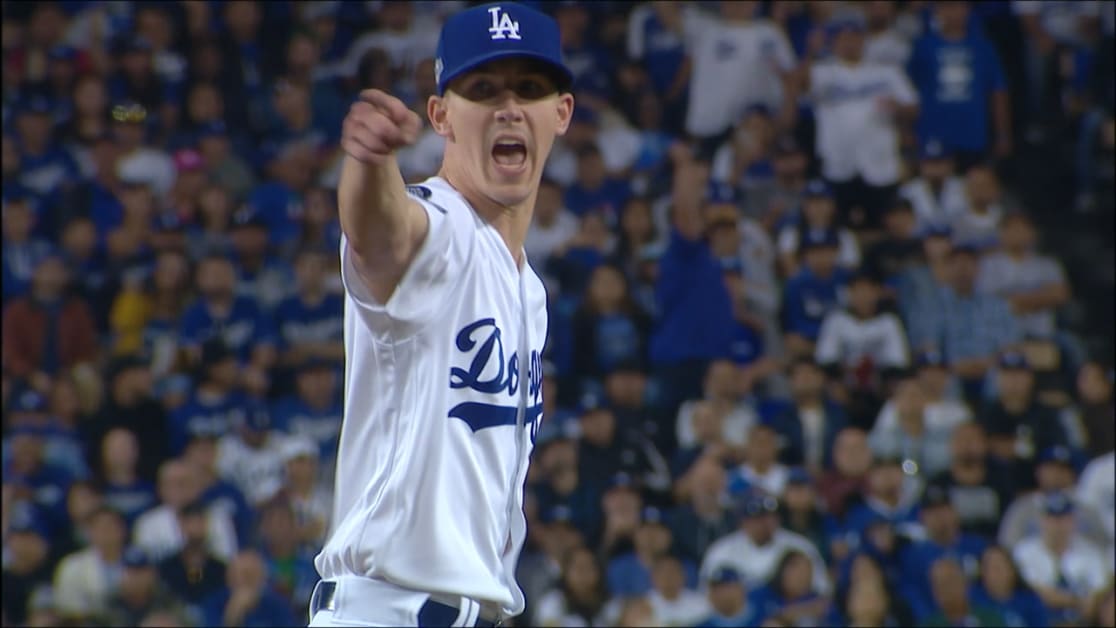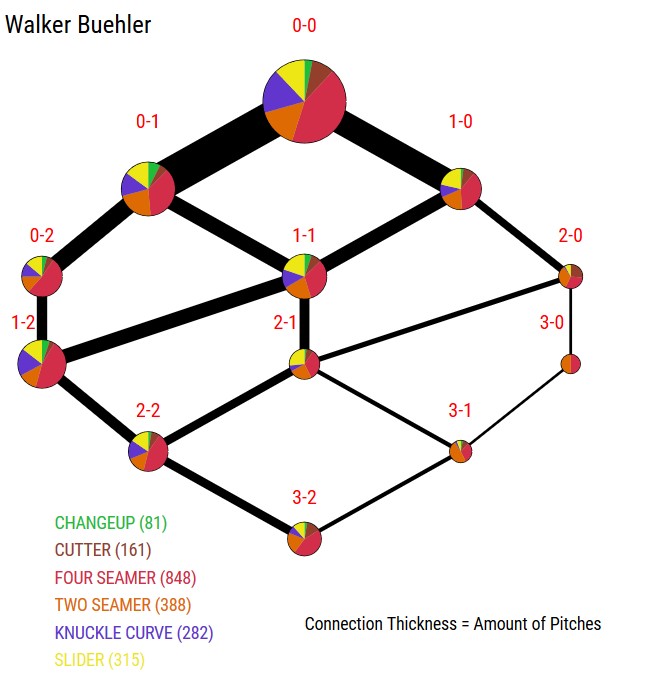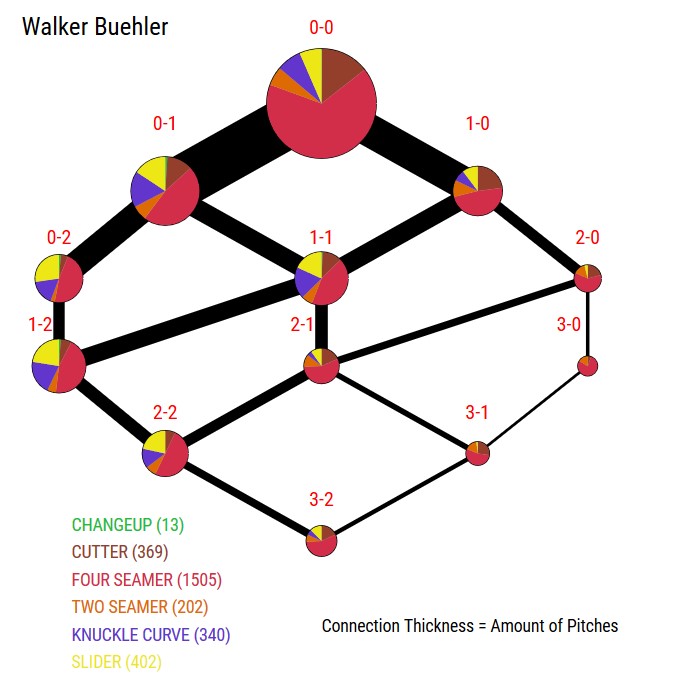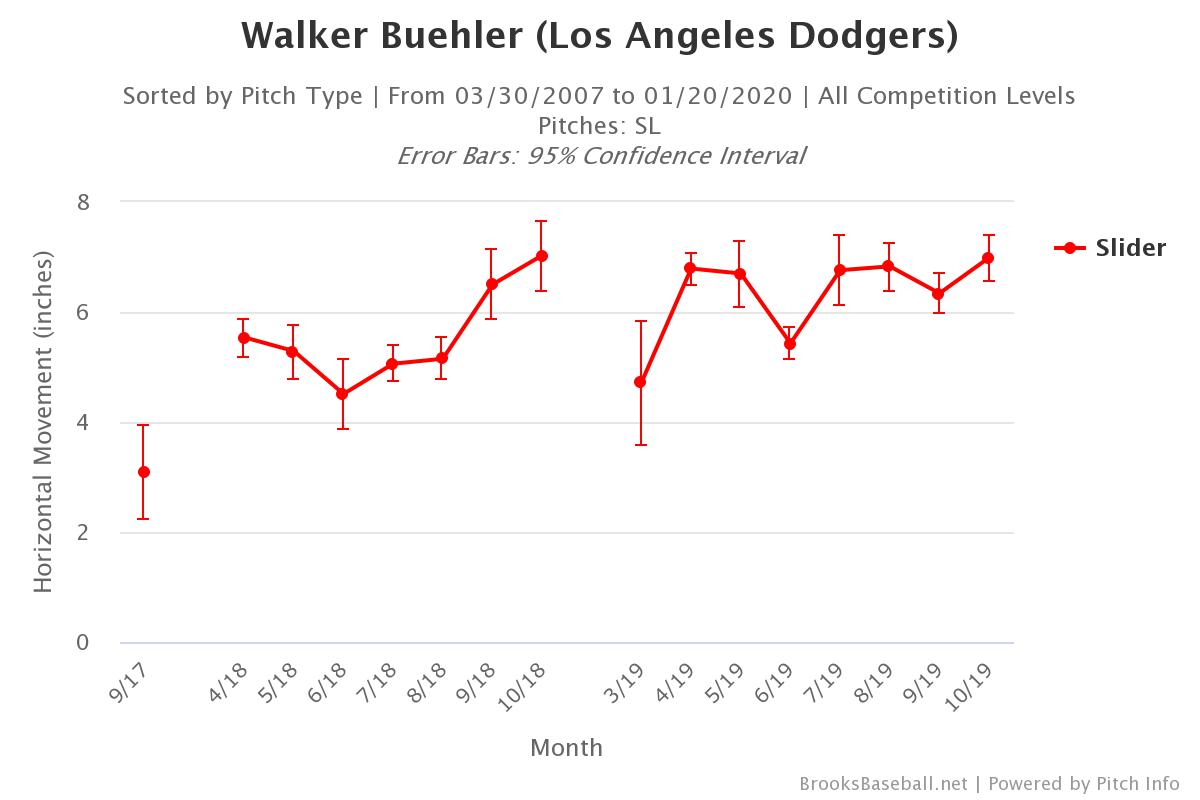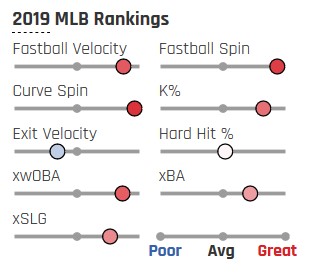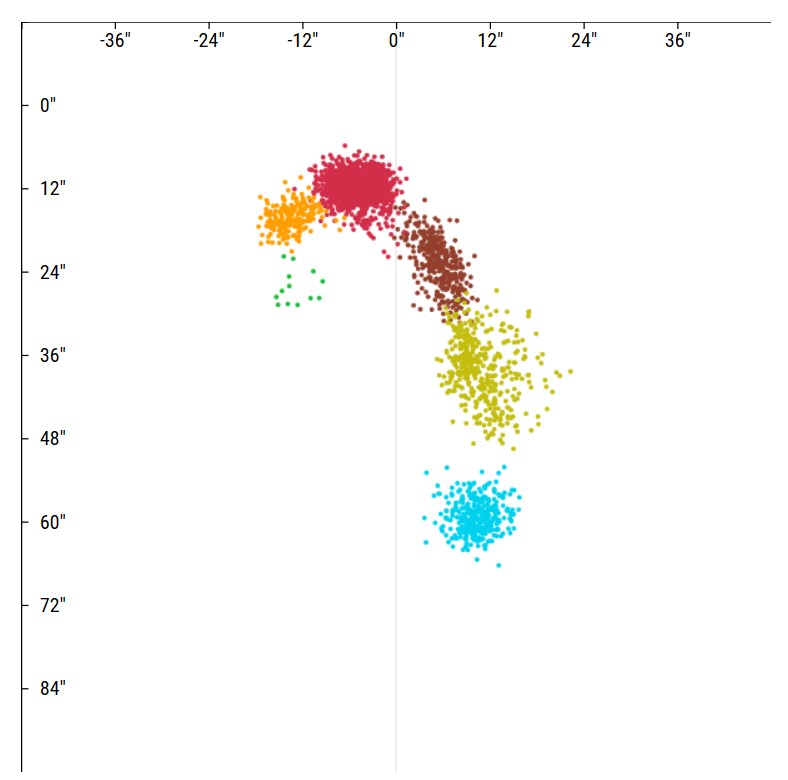While producing a dominant season in 2019, Walker Buehler did so as he significantly changed his pitch usage.
Clearly it was for the better as it led to a rise in strikeouts, with his strikeout percentage rising to 29.2 from 27.9, and a drop in walks as his walk percentage landed at 5.0 from 6.8 in 2018. The resulting K-BB% of 24.2 finished 7th among qualified pitchers in baseball, behind four pitchers you’d expect (Gerrit Cole, Justin Verlander, Max Scherzer, Jacob deGrom) and two of the league’s other top young pitchers (Shane Bieber and Lucas Giolito). The change also lead to Buehler’s ground-ball rate dropping (50% to 42.7%), but much of that is explained away in the changes between 2018 and 2019.
A look at the differences
First, here’s the 2018 season from Buehler:
| 2018 Pitches (87.5 Exit Velo) | Righties- 1,036 26.9 Whiff% | Lefties- 1,044 24.5 Whiff% |
| 4-seam 30.8 Whiff% | 443, 42.76% 31.6 Whiff% | 405, 38.79% 30 Whiff% |
| 2-seam 16.9 Whiff% | 208, 20.07% 11.0 Whiff% | 183, 17.52% 23.6 Whiff% |
| Cutter 18.2 Whiff% | 58, 5.59% 20 Whiff% | 103, 9.86% 17.2 Whiff% |
| Slider 30.2 Whiff% | 209, 20.17% 35.9 Whiff% | 108, 10.34% 19.4 Whiff% |
| Knuckle Curve 27.2 Whiff% | 113, 10.90% 23.3 Whiff% | 169, 16.18% 30 Whiff% |
| Changeup 7.1 Whiff% | 5, 0.2% 0 Whiff% | 76, 7.27% 7.9 Whiff% |
To right-handed batters, it’s a pretty significant mix of three pitches as the four-seamer, two-seamer and slider make up 83% of the 1036 thrown. The variance was a bit higher to lefties, with the top three pitches making up 72.5% as Buehler used the curve significantly more as an out pitch to lefties in place of his slider’s role against righties.
Now in 2019, there’s differences all around:
| 2019 Pitches (88.6 Exit Velo) | Righties- 1348 30.6 Whiff% | Lefties- 1483 28.5 Whiff% |
| 4-seam 24.6 Whiff% | 739, 54.82% 28.1 Whiff% | 766, 51.65% 21.3 Whiff% |
| 2-seam 13.7 Whiff% | 70, 5.19% 15.0 Whiff% | 132, 8.9% 12.9 Whiff% |
| Cutter 26.6 Whiff% | 172, 12.75% 32.7 Whiff% | 197, 13.28% 21.0 Whiff% |
| Slider 32.2 Whiff% | 232, 17.21% 37.7 Whiff% | 170, 11.46% 25.2 Whiff% |
| Knuckle Curve 37.3 Whiff% | 135, 10.01% 36.4 Whiff% | 205, 13.82% 37.7 Whiff% |
| Changeup 0.0 Whiff% | 0, 0.0% 0 Whiff% | 13, 0.87% 0 Whiff% |
While the changes can be seen pretty clearly between the two seasons, things first started evolving back in 2018. Patrick Brennan’s story for Beyond The Box Score explained a bit on why this change began.
As is shown pretty clearly above, Buehler’s change-up essentially disappeared and his two-seamer went from basically being the second most-used pitch down to his fifth. The 15% drop off to righties the most significant change of any pitch to batters on either side of the plate. In its place, Buehler primarily did a pair of things. First, he picked up his cutter usage, a wise move given where it ranked in baseball during 2019. And secondly, he simply started using his four-seamer to set up more often early in counts.
Of the five pitches he threw to right-handed batters in 2019, only the two-seamer failed to reach a Whiff% of at least 28 as it lagged well behind. Even without numbers attached to them, Baseball Savant’s plinko charts for 2018 and 2019 give a clear sense of how the usage changed based on the count over the two-year stretch.
As Brennan mentioned in that March 2019 story, citing another story from Shi Davidi and Ben Nicholson-Smith, Buehler mentioned the desire for a hard pitch with lateral movement. And while the cutter did just that (more on it to come), Buehler’s slider also generated more consistent horizontal movement in 2019 than it did in 2018 according to Brooks Baseball.
Changes in spin and movement
Unsurprisingly, Buehler ranked high across most of baseball’s rankings. Buehler’s four-seamer averaged 96.5 mph and a spin rate of 2,467 rpm in 2019, both among the league’s top 65 of 675 pitchers. His curve’s spin rate finished at 2,947 to rank 21st of 454 pitchers.
All five of Buehler’s primary pitches saw an increase in spin rate from 2018 to 2019. While the four-seamer (50 rpm), two-seamer (51 rpm) and cutter (54 rpm) all increased by a similar rate, Buehler’s slider and curve significantly increased, as did their active spin rate.
Jumping from 2,767 rpm in 2018, Buehler’s slider finished 2019 at 2,901 rpm to finish 16th of 549 pithers. With the average velo coming in at about the same number between the two years, Buehler’s active spin rate moved up to 52.4% from 44.6%. That’s where the horizontal movement increase mentioned above comes in. Baseball Savant lists Buehler’s horizontal movement at an average of 11.1 inches away from right-handed batters, 6.7 inches more than the average and 151% break more than the average. Baseball Savant defines the movement of a pitch compared to the average by comparing it to other pitch types within 2 mph higher or lower and from within 6 inches more or less of extension and release. Ranking 4th in baseball on the % break vs. the average, Buehler’s slider increased its movement 2.2 inches horizontally and the % break improved 41%.
Meanwhile, his curve’s 14% drop vs. the average came in 8th in baseball with the spin rate 21st and active spin up to 87.9% from 82.9% in 2018. And Buehler’s cutter finished 5th in at 200% break vs. the average thanks to the 7th-best spin rate and 17th-best velocity.
As the rates against baseball’s average increased, so did the Whiff% of most of Buehler’s pitches. The curve and cutter each jumped more than 10% against righties while the slider increased despite already sitting at 35.9% in 2018. While not as predominant against lefties, Buehler’s numbers still rose between 4% and 7% on the cutter, slider and curve.
——
The result of Buehler’s mix of pitches? The graph below shows the variety of locations he hit in 2019. His four-seamer is shown in red, with the two-seamer in orange (with the few change-ups under that in green) and cutter in brown. The sliders fall below the cutters in green, with his curve wrapping up the arsenal in blue.
There’s plenty more that could be said on Buehler, as there’s few other pitchers who rank within the top 10 of % break vs. the average on three pitches. How he uses his array of options in 2020 will be fun to keep an eye on after the change between his first two full seasons.
 Dodgers Digest Los Angeles Dodgers Baseball Blog
Dodgers Digest Los Angeles Dodgers Baseball Blog
